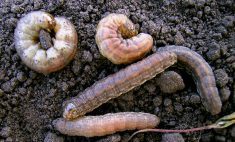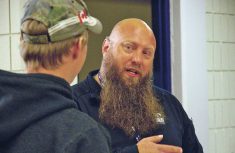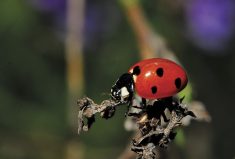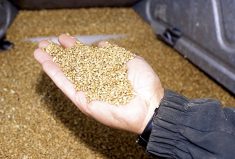The province has gained one new entomologist but has lost its best-known bug specialist.
Boyd Mori, a new assistant professor in the University of Alberta’s agriculture department, paid tribute to provincial insect management specialist Scott Meers in his presentation at FarmTech — and urged his audience to lobby the government for a replacement.
“Scott Meers is a big part of this talk,” said Mori, who obtained his PhD at the U of A and worked for Agriculture and Agri-Food Canada in Saskatoon.
“Scott is retiring, we are going to need a new insect management specialist with the province, so make sure to pressure your MLAs. A lot of the work that is going to be presented today wouldn’t happen without Scott and (provincial insect technologist) Shelley (Barkley)… We have to keep the pressure on our current government to make sure it staffs these positions not just in entomology, but in other positions as well, so we have capacity and can continue to build it.”
Read Also

Grazing ‘sweet spot’ boosts pasture performance
Timing-focused approach to pasture management touted to boost forage growth, livestock gains while also cutting farmer labour and inputs
Mori, whose five-year position is sponsored by the four crop commissions, has focused on integrated pest management, insect/pest interactions and developing pest monitoring tools.
Entomologists in the province and across the country collaborate extensively, he said, and he said producers should follow the Alberta Insect Monitoring Network (run by Meers and Barkley) and the Prairie Pest Monitoring Network (run by Jennifer Otani at Ag Canada’s Beaverlodge station and her colleague Meghan Vankosky in Saskatoon).
“All of the information that producers collect, and that Scott and Shelley collect, gets fed into the Prairie Pest Monitoring Network,” he said. “This helps feed our forecasting and our monitoring that we have during the growing season.”
The Prairie Pest Monitoring Network blog and e-newsletter while the Alberta Insect Monitoring Network has live, in-season maps for pests such as wheat midge, bertha army worm and diamondback moth.
On the radar
There are a number of pests farmers should be scouting for in 2020, said Mori, crediting Meers for most of the information he presented.
Producers should be on the watch for bertha army worms, particularly in the Peace, where high numbers were captured in traps set up and monitored by collaborators working with Meers and Barkley.
“If you’re familiar with bertha army worm, it has a six- to seven-year cycle,” said Mori. “It should be starting to fizzle out in the Peace but we really need to be alert again.”
Pea leaf weevils have been a problem in north-central Alberta.
“You can find it in your field because of its characteristic U-shaped notching,” he said. “The Prairie Pest Monitoring Network is out there surveying fields and looking for this notching on the leaves.”
But producers should also be pulling plants to check roots for larvae as adults lay their eggs on the soil and larvae feed on root nodules.
“It’s the feeding on the root nodules that can really reduce your yield,” he said.
While pea leaf weevils enjoy peas, fababeans are the preferred host. Faba growers should consider using a seed treatment.
“If you’re growing faba in this region, you’re going to have a lot more damage from pea leaf weevils,” said Mori.
Pea leaf weevil was confirmed in the Peace region in 2017.
“It’s a fairly new invader but seems to be established in the Municipal District of Smoky River, but not at very high levels,” said Mori, adding the pest was historically a problem in southern Alberta before making a big leap into the central part of the province. Growers in the south should continue to use a seed treatment.
Cabbage seed pod weevil is another pest to watch for. In the spring, it attaches to canola flowers.
“Adults will chew a little hole in the developing pod, lay an egg or two and the larvae continue in that developing pod, consuming it,” he said. “The best way to monitor is to be out there with your sweep net at 10 to 20 per cent flower.”
Recent work by Hector Carcamo, an Ag Canada research scientist in Lethbridge, and Meers determined a spraying threshold of 2.5 weevils per sweep.
Mori recommended sampling four locations through a field and taking 25 sweeps at each location. (Meers has a YouTube video titled ‘Proper Sweepnet Technique for Cabbage Seedpod Weevil.’)
Weevils will often head to the first field in flower, and have been an issue in southern Alberta.
Entomologists across the Prairies are currently doing research on parasitoids that can control this pest.
Wheat midge has been another pest that has caused trouble in Alberta. However, wheat midge needs a lot of moisture, so it hasn’t been as active in recent years. Mori recommended looking into wheat midge-tolerant varieties for producers who have had issues with the pest in the past, as well as monitoring for midge by going out around dusk and looking for midge on wheat heads.
















